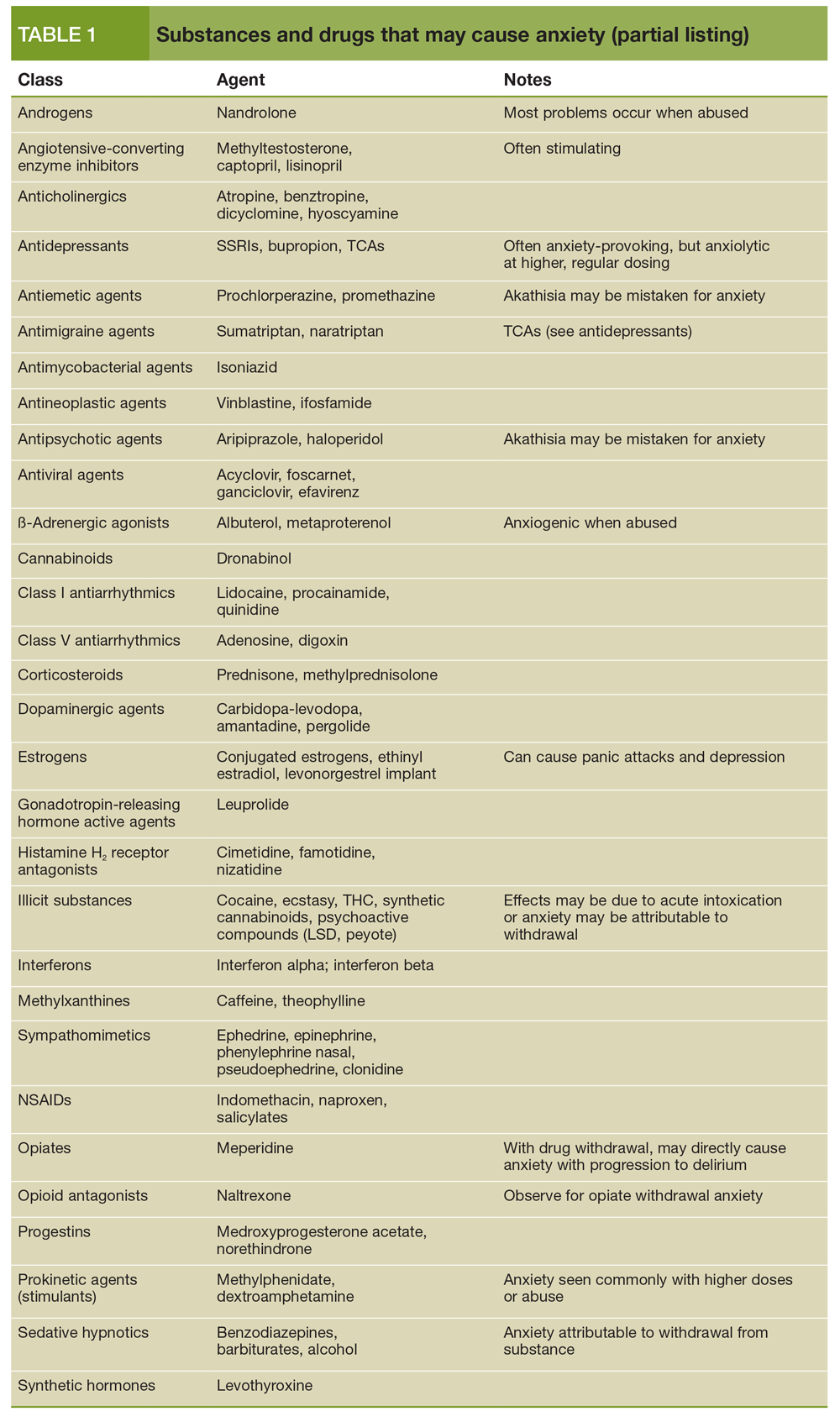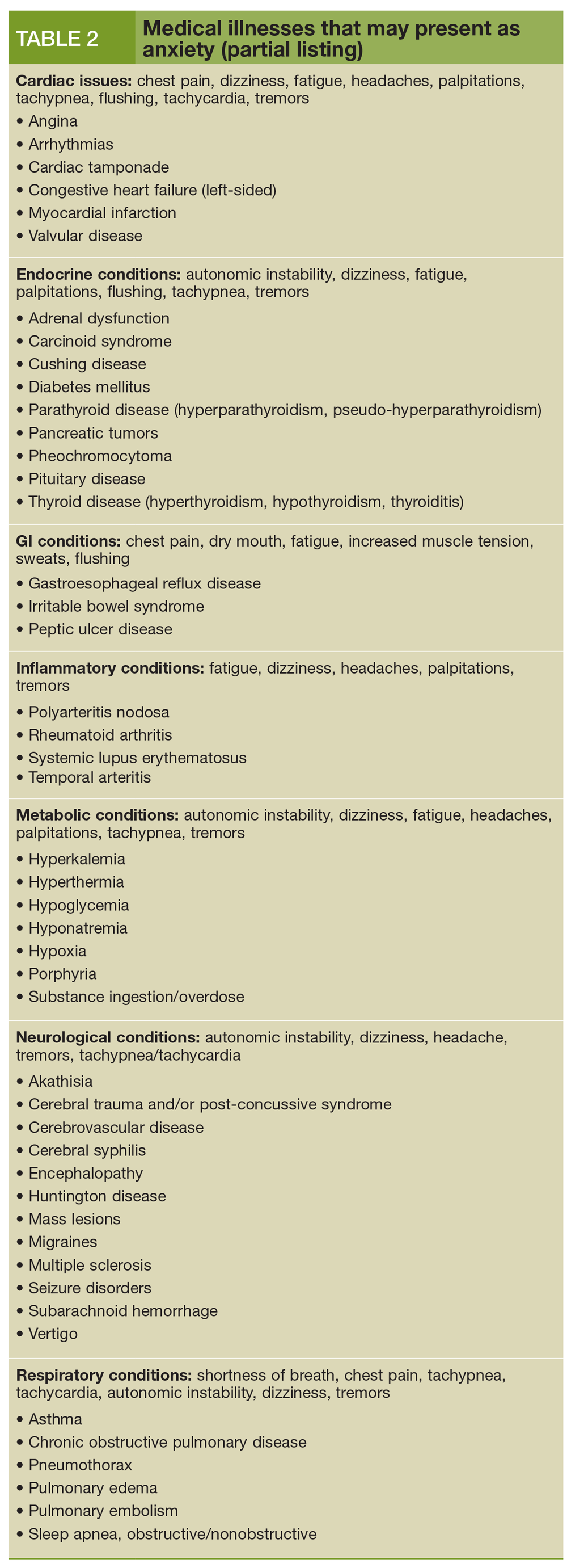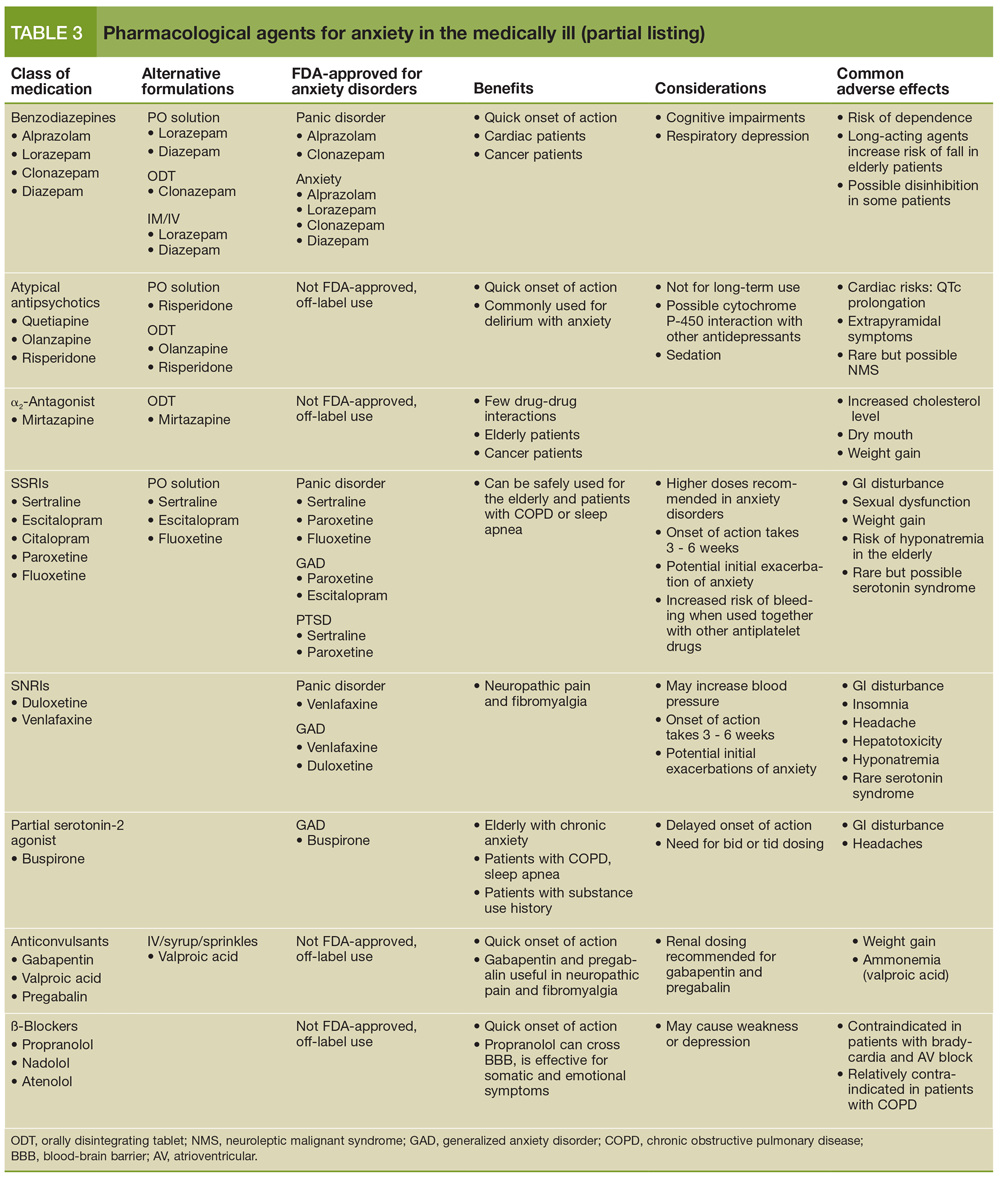Publication
Article
Managing Anxiety in the Medically Ill
Author(s):
The authors examine anxiety in the medically ill: its presence secondary to or as an impersonator of physical illness and its diagnostic and management challenges.
TABLE 1: Substances and drugs that may cause anxiety (partial listing)

TABLE 2: Medical illnesses that may present as anxiety (partial listing)

TABLE 3: Pharmacological agents for anxiety in the medically ill (partial listing)

Anxiety is a fundamental aspect of the human experience. It can be an adaptive response to a perceived threat, with both psychological and physiological features. In the short term, anxiety can be a motivator and prepare one to confront a crisis. When anxiety persists or occurs abnormally, it can impair functioning and lead to an anxiety disorder. In the medical setting, anxiety can be a normal coping mechanism when dealing with the stress of illness. However, if it exceeds social, psychological, or physiological needs, anxiety can become maladaptive-leading to somatic symptoms that cause distress and impairment.
Prevalence of anxiety in the medically ill
Patients with primary anxiety disorders, such as generalized anxiety disorder (GAD), panic disorder, and phobias, as well as PTSD, report a higher rate of certain medical illnesses than are observed in the general population. The National Comorbidity Survey Replication showed a 12-month prevalence rate of 3.1% for GAD and a lifetime prevalence rate of 5.7%; the lifetime prevalence for panic disorder was found to be 4.7%, with a 12-month prevalence of 5.7%.1 In comparison, the general prevalence of GAD in primary care is thought to be 8%.2 Findings from Fleet and colleagues3 suggest that an estimated 25% of 441 chest pain complaints in an emergency department (ED) setting were due to panic attacks.
Related content:
7 Medical Illnesses That May Present as Anxiety
Specific medical phobias, such as fear of blood, needles, or MRIs (due to claustrophobia), are quite common. Combined blood-injectioninjury phobias have been found to have a lifetime prevalence of over 3% in a general population sample.4 The presence of these phobias is of concern because they can contribute to patients having difficulty in pursuing medical care.
The lifetime prevalence of PTSD is 6.8%, with a 12-month prevalence estimated to be 3.5% in the general population.1 In a primary care setting, 12% of patients examined were found to have PTSD5; 30% to 40% of motor vehicle accident survivors were found to have PTSD, so were 20% to 45% of burn victims.6 The diagnosis of an acute distress disorder strongly predicted the presence of PTSD 6 months later.7 Although PTSD and acute stress disorder are categorized under trauma and stressor-related disorders in DSM-5, in this article, PTSD is considered as a primary anxiety disorder.
Impact of anxiety disorders on medical illness
Anxiety disorders cause diminished functioning and well-being along with increased suffering; these effects are amplified in the presence of comorbid medical illness. As a group, they contribute to symptom severity in medical populations, functional impairment, and increased risk of disease progression. Anxiety also plays a role in increased health care use and cost, greater number of iatrogenic complications, and decreased adherence to treatment.
Beyond psychosocial implications of anxiety disorders, there are also physiological effects of anxiety. Anxiety can create excessive sympathetic activation, alteration in inflammatory response, and disruption of the hypothalamic-pituitary-adrenal axis-predisposing patients to increased health risks. Comorbid anxiety disorders and medical illnesses often lead to a self-perpetuating cycle in which a chronic medical illness negatively affects level of function, leading to depression and anxiety, which, in turn, can worsen the underlying medical condition. The dynamic interplay between comorbid anxiety disorders and medical illnesses can pose diagnostic and management challenges.
Primary anxiety disorders and comorbid physical illnesses
Patients with primary anxiety disorders are more likely to suffer from GI, respiratory, cardiac, and neurological disorders, even after adjusting for confounding factors such as sex, depression, and substance use disorders. Among patients with panic disorder, GAD, and PTSD, rates of irritable bowel syndrome are much higher than in those with no psychiatric diagnoses. Similarly, panic disorder, GAD, and phobias are strongly associated with asthma and cancer. Anxiety disorders are associated with an increased incidence of cardiovascular disease, such as myocardial infarction, angina, sudden cardiac death, and hypertension, and frequent panic attacks are associated with worse cardiac outcomes. PTSD is associated with increased risk of cardiovascular disease, increased rates of re-hospitalization, and decreased adherence to treatment regimens. Primary anxiety disorders, particularly panic disorder, are also comorbid with seizure disorder. Finally, social anxiety disorder and panic attacks are often seen in patients with Parkinson disease.8
Secondary anxiety and secondary anxiety disorders
Since there is a bidirectional relationship between anxiety and medical illnesses, many severe medical conditions can lead to secondary anxiety that ranges from normal psychological reactions to illness to intense anxiety or preoccupation about somatic sensations, which result in impaired functioning. A diagnosis of a severe, chronic, or debilitating medical illness will invariably elicit a number of negative emotions, such as anxiety, fear, sadness, and anger. When the emotional reactions are out of proportion to the context and lead to significant impairment in functioning, secondary anxiety disorder (ie, adjustment disorder with anxiety) can be the result.
DSM-5 conceptualizes adjustment disorder as a stress-response syndrome that occurs after exposure to a distressing event and is listed under traumaand stressor-related disorder. Secondary anxiety can also result from the effects of substance use, either from intoxication or withdrawal from a drug or anxiety as an adverse effect of a medication. Table 1 lists agents that may cause anxiety.
Anxiety secondary to general medical conditions
Some medical disorders, such as pheochromocytoma and hyperthyroidism, can produce anxiety directly by affecting neuroendocrine systems. Other medical disorders produce anxiety indirectly through autonomic arousal that the patient interprets as a psychological state, such as anxiety experienced during an acute myocardial infarct or pulmonary embolism. Medical conditions that can produce symptoms of anxiety are listed in Table 2.
Anxiety as an impersonator of medical illness
Anxiety can be camouflaged as somatic symptoms to mimic a medical illness, especially in the primary care setting. Some of the somatic expressions of anxiety include tachycardia, palpitations, sweating, flushing, dry mouth, dizziness, tremor, muscle tension, headaches, and fatigue. These symptoms could present as a “false alarm” because of an underlying anxiety disorder or a somatoform disorder. The somatic component complicates the overall picture and results in more functional impairment and higher use of medical resources.
There is a major revision of somatoform disorders in DSM-5. Psychological factors affecting medical conditions is a new diagnosis under the classification of somatic symptom and related disorders. Psychological factors include psychological distress, patterns of interpersonal interaction, coping style, and maladaptive health behaviors. In DSM-5, individuals with high health anxiety and significant somatic symptoms are given a diagnosis of somatic symptom disorder; this replaces somatization disorder in DSM-IV. Alternatively, individuals with high health anxiety without somatic symptoms may receive a diagnosis of illness anxiety disorder, which replaces hypochondriasis in DSM-IV.
Diagnostic and management challenges
The anxious patient in the medical setting can be diagnostically challenging. A key component to the clinical approach toward an anxious patient is differentiating pathological anxiety from a regular emotional response. If an anxious response is disproportional to a medical illness or illness exacerbation, etiologies for anxiety need to be investigated systematically using a biopsychosocial approach.
Biologically, acute anxiety may be the first sign of exacerbation of an underlying illness, an undiagnosed medical condition, or substance intoxication or withdrawal. To aid in diagnosis, the patient examination includes a detailed history; focused physical examination; complete review of medications; collateral information; and diagnostic testing, such as toxicology screens. For example, a patient with a history of myocardial infarction may present to the ED with panic attacks along with palpitation and numbness. The treating physician must first rule out recurrent cardiac abnormalities, pulmonary issues, new-onset neurological abnormalities, medication or substance intoxication/withdrawal, and other conditions that require immediate interventions.
Psychologically, an anxious reaction to a medical illness may be due to a patient’s uncertainty regarding a medical diagnosis or prognosis. In the medical or surgical ward, factors that contribute to anxiety include being unfamiliar with the hospital setting, staff, and procedures. From a social perspective, fears about losing functional capacity or becoming overly dependent on others may be a contributing factor; fear of death is another source of anxiety. Involvement of family and social supports can provide greater reassurance in these situations.
Managing acute anxiety pharmacologically differs significantly from managing chronic anxiety disorders (Table 3). Benzodiazepines are effective for acute anxiety and ideally should be limited to short-term use. Lorazepam is commonly used for anxiety-induced chest pain or anxiety associated with chest pain. Patients with cancer comorbidities may benefit from benzodiazepines because they also help with nausea and insomnia. Benzodiazepines should be used with caution in patients with a history of substance abuse and in the elderly who have cognitive impairment and who may be at risk for falling. Benzodiazepines can also decrease respiratory drive in patients with obstructive sleep apnea and severe chronic obstructive pulmonary disease (COPD).
Low-dose atypical antipsychotics (such as quetiapine, risperidone, and olanzapine) are effective in acute debilitating anxiety that causes obsession, disorganized thinking, and overwhelming distress and that interferes with medical care9; however, there is no well-designed study of this class in the treatment of anxiety. Mirtazapine, an α2-antagonist and serotonin antagonist, has been found to work quickly and effectively for acute anxiety associated with insomnia and poor appetite.4,10 Orally disintegrating tablets of mirtazapine, clonazepam, olanzapine, and risperidone are available and may be helpful for patients with dysphagia or with a diet restriction. Some of the benzodiazepines and atypical antipsychotics also have oral solution and injectable forms, which are very useful in acute medical and surgical settings.
In outpatient clinics, a patient’s anxiety may arise from a perceived negative self-image in the physician’s eyes. This example may be particularly pertinent in situations in which patients either caused or exacerbated their illness (eg, tobacco use). Excessive worry in these situations may contribute to reluctance in following up with health care appointments, and to denying or failing to disclose information that ultimately leads to treatment delays or less optimal treatment. Therefore, while firm reminders are appropriate, harsh critique of the patient is unwarranted and may contribute to poorer treatment adherence.
SSRIs are the first-line agents for chronic anxiety disorders and are generally well tolerated by elderly patients.11 Sertraline, citalopram, and escitalopram have fewer drug-drug interactions than paroxetine and fluoxetine.9 Sertraline has the most evidence of safety and effectiveness in patients with significant cardiovascular disease.12-14
SNRIs, such as duloxetine and venlafaxine, are FDA-approved for primary anxiety disorders and neuropathic pain. Buspirone, a partial serotonin-2 agonist, is recommended for chronic anxiety in the elderly and in patients with COPD, sleep apnea, or substance abuse. Buspirone is a category B drug for pregnancy and thus is not expected to harm an unborn baby; the other anxiolytic agents are classified under category C or D.
Anticonvulsants and β-blockers can be used for both acute and chronic anxiety. Valproic acid is used for anxious agitation seen in patients with traumatic brain injury, mental retardation, or advanced dementia. Gabapentin, a γ-aminobutyric acid (GABA) analogue, is not only effective in patients with acute GABAergic withdrawal anxiety but is also used off-label for chronic anxiety, such as panic disorder and PTSD. Pregabalin can be considered for social phobia and GAD. β-Blockers reduce the sympathetic surge of anxiety, as seen in performance anxiety and social phobia4; they are also the first-line treatment for akathisia as an acute form of anxiety.
Psychotherapy is also effective for managing anxiety in the medically ill. Supportive therapy and brief cognitive-behavioral therapy can be readily used at bedside or in an office. Psychodynamic psychotherapy is an option for those patients who are more resilient and whose condition is less acute. Other therapies, such as hypnosis, meditation, and biofeedback, can play a role in both anxiety and physical symptoms.
Treatment modalities should be discussed with the patient to ensure autonomy, minimize the subjective feeling of losing control, increase adherence, and ultimately strengthen the therapeutic alliance. Collaboration with other treatment teams is essential in reducing health care utilization.
Disclosures:
Dr Dong is Assistant Professor of Psychiatry at INOVA Fairfax Hospital in Falls Church, Va. Drs Noorani and Vyas are Psychiatry Residents in the department of psychiatry and behavioral sciences at The George Washington University, in Washington, DC. Drs Balgobin and Torres-Llenza are Psychosomatic Medicine Fellows at INOVA Fairfax Hospital and The George Washington University. Dr Crone is Associate Professor of Psychiatry at INOVA Fairfax Hospital and The George Washington University. The authors report no conflicts of interest concerning the subject matter of this article.
References:
1. Kessler RC, Chiu WT, Demler O, et al. Prevalence, severity, and comorbidity of 12-month DSM-IV disorders in the National Comorbidity Survey Replication. Arch Gen Psychiatry. 2005;62:617-627.
2. Wittchen HU. Generalized anxiety disorder: prevalence, burden, and cost to society. Depress Anxiety. 2002;16:162-171.
3. Fleet RP, Dupuis G, Marchand A, et al. Panic disorder in emergency department chest pain patients: prevalence, comorbidity, suicidal ideation, and physician recognition. Am J Med. 1996;101:371-380.
4. Epstein SA, Hicks D. Anxiety disorders. In: Levenson JL, ed. The American Psychiatric Publishing Textbook of Psychosomatic Medicine: Psychiatric Care of the Medically Ill. 2nd ed. Arlington, VA: American Psychiatric Publishing, Inc; 2011:241-261.
5. Stein MB, McQuaid JR, Pedrelli P, et al. Posttraumatic stress disorder in the primary care medical setting. Gen Hosp Psychiatry. 2000;22:261-269.
6. McKibben JB, Bresnick MG, Wiechman Askay SA, Fauerbach JA. Acute stress disorder and posttraumatic stress disorder: a prospective study of prevalence, course, and predictors in a sample with major burn injuries. J Burn Care Res. 2008;29:22-35.
7. Zatzick DF, Kang SM, Müller HG, et al. Predicting posttraumatic distress in hospitalized trauma survivors with acute injuries. Am J Psychiatry. 2002;159:941-946.
8. Roy-Byrne PP, Davidson KW, Kessler RC, et al. Anxiety disorders and comorbid medical illness. Gen Hosp Psychiatry. 2008;30:208-225.
9. Hicks DW, Raza H. Facilitating treatment of anxiety disorders in patients with comorbid medical illness. Curr Psychiatry Rep. 2005:7;228-235.
10. Wise MG, Rieck SO. Diagnostic considerations and treatment approaches to underlying anxiety in the medically ill. J Clin Psychiatry. 1993;54(suppl): 22-26.
11. Flint AJ. Generalised anxiety disorders in elderly patients: epidemiology, diagnosis and treatment options. Drugs Aging. 2005;22:101-114.
12. Davies SJ, Jackson PR, Potokar J, Nutt DJ. Treatment of anxiety and depressive disorders in patients with cardiovascular disease. BMJ. 2004;328: 939-943.
13. Serebruany VL, Glassman AH, Malinin AI, et al; Sertraline Sertraline AntiDepressant Heart Attack Randomized Trial Study Group. Platelet/endothelial biomarkers in depressed patients treated with the selective serotonin reuptake inhibitor sertraline after acute coronary events: the Sertraline AntiDepressant Heart Attack Randomized Trial (SADHART) Platelet Substudy [published correction appears in Circulation. 2003;108:3165]. Circulation. 2003;108:939-944.
14. Berkman LF, Blumenthal J, Burg M, et al; Enhancing Recovery in Coronary Heart Disease Patients Investigators. Effects of treating depression and low perceived social support on clinical events after myocardial infarction: the Enhancing Recovery in Coronary Heart Disease Patients (ENRICHD) Randomized Trial. JAMA. 2003;289:3106-3116.






